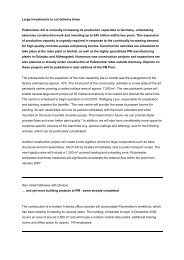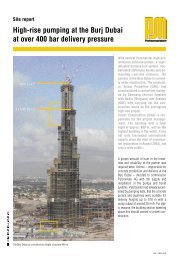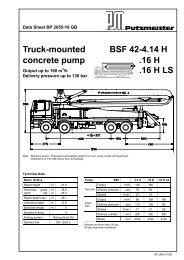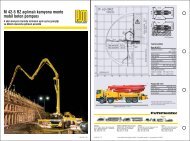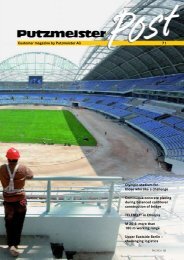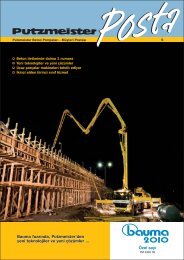“New Harbour” in Doha/Qatar - Putzmeister Holding GmbH
“New Harbour” in Doha/Qatar - Putzmeister Holding GmbH
“New Harbour” in Doha/Qatar - Putzmeister Holding GmbH
You also want an ePaper? Increase the reach of your titles
YUMPU automatically turns print PDFs into web optimized ePapers that Google loves.
<strong>Putzmeister</strong> Industrial Technology<br />
<strong>Putzmeister</strong> Industrial Technology<br />
p Biological waste can look like this:<br />
Leftover and spoiled food mixed with<br />
foreign objects<br />
p Perfect: The actual biomass substrate<br />
after press<strong>in</strong>g <strong>in</strong> the EKO 1060 PP<br />
25<br />
26<br />
27<br />
How is organic waste<br />
turned <strong>in</strong>to biomass?<br />
Foreign objects severely impair the process<br />
of extrud<strong>in</strong>g methane from biomass<br />
consist<strong>in</strong>g of leftover food, spoiled food<br />
or other organic waste.<br />
Leftover food mixed with packaged food<br />
is processed <strong>in</strong> the BioPower (Bernau,<br />
Germany), M.U.T. (Kössen, Austria) and<br />
Bioenergie (Schlitters, Austria) plants.<br />
Dur<strong>in</strong>g the process, spoiled food is removed<br />
from packag<strong>in</strong>g <strong>in</strong> a separate subprocess<br />
(separator) whereby a high density<br />
solids pump conveys the solid parts (e.g.<br />
packag<strong>in</strong>g and plastic conta<strong>in</strong> ers, glass,<br />
paper and alum<strong>in</strong>ium foil) <strong>in</strong>to a conta<strong>in</strong>er.<br />
The substrate (the valuable residual<br />
material) flows through the press<strong>in</strong>g<br />
cyl<strong>in</strong>der where it is transferred to a fermenter<br />
by a high density solids pump.<br />
The organic matter can be boiled and<br />
pressed aga<strong>in</strong> to extract the residual biological<br />
waste. F<strong>in</strong>ally, the rema<strong>in</strong><strong>in</strong>g<br />
packag<strong>in</strong>g material is transported to a<br />
domestic waste <strong>in</strong>c<strong>in</strong>eration plant for<br />
disposal.<br />
28<br />
<strong>Putzmeister</strong> converts waste <strong>in</strong>to<br />
high-quality biomass <strong>in</strong> five steps<br />
Leftover food, spoiled food and other organic waste products can be used as valuable biomass. However, sometimes the<br />
products are still <strong>in</strong> their packag<strong>in</strong>g or mixed with crockery and cutlery. These foreign objects impair the process of extrud<strong>in</strong>g<br />
methane from the biomass because they reduce the active volume and efficiency of the plant.<br />
Here are five simplified steps that show how the EKO 1060 PP efficiently separates the actual biomass from foreign objects.<br />
1. The processed biomass flows <strong>in</strong>to the<br />
cyl<strong>in</strong>der chamber on the EKO 1060 PP. The<br />
delivery piston is located <strong>in</strong> the rear position<br />
while the shut-off gate valve is closed.<br />
1<br />
29<br />
Supply l<strong>in</strong>e for the processed or<br />
pulverised biomass<br />
Perforated<br />
cyl<strong>in</strong>der with<br />
spray guard<br />
2. The delivery piston then moves forwards.<br />
The biomass is compressed and already<br />
beg<strong>in</strong>s to pass through the holes <strong>in</strong><br />
the perforated cyl<strong>in</strong>der. The shut-off gate<br />
valve is closed.<br />
2<br />
p The rema<strong>in</strong>der is discarded:<br />
Packag<strong>in</strong>g and other foreign objects<br />
Feed open<strong>in</strong>g<br />
Gate<br />
valve<br />
3. The delivery piston then plunges <strong>in</strong>to<br />
the perforated cyl<strong>in</strong>der. The biomass is<br />
compressed further and the organic portion<br />
is pressed through the holes <strong>in</strong> the cyl<strong>in</strong>der.<br />
Any <strong>in</strong>ert foreign objects, i.e. stable<br />
and non-reactive under the current conditions,<br />
rema<strong>in</strong> <strong>in</strong> the cyl<strong>in</strong>der.<br />
3<br />
4. The shut-off gate valve opens. The foreign<br />
objects are then ejected <strong>in</strong>to the delivery<br />
l<strong>in</strong>e where they are “boiled” to hydrolyse<br />
any rema<strong>in</strong><strong>in</strong>g biomass and separate it<br />
from the foreign objects dur<strong>in</strong>g an additional<br />
press<strong>in</strong>g process.<br />
4<br />
5<br />
5. The delivery piston moves back to the<br />
forward position and the process starts<br />
aga<strong>in</strong> from the beg<strong>in</strong>n<strong>in</strong>g.<br />
Delivery l<strong>in</strong>e for the<br />
biomass substrate<br />
L<strong>in</strong>e for foreign<br />
16<br />
objects<br />
17



![Data sheet BSA 1005 D SV (TB 2206) [.pdf; 459.58 kb] - Putzmeister](https://img.yumpu.com/51174022/1/184x260/data-sheet-bsa-1005-d-sv-tb-2206-pdf-45958-kb-putzmeister.jpg?quality=85)
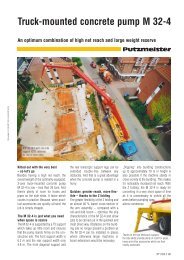
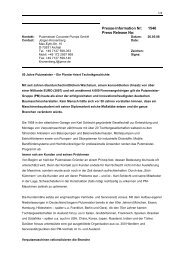
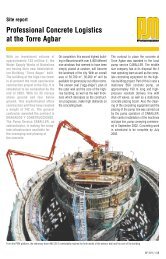
![Typenblatt CS 3095 [.pdf; 202.40 kb] - Putzmeister](https://img.yumpu.com/50530164/1/184x260/typenblatt-cs-3095-pdf-20240-kb-putzmeister.jpg?quality=85)
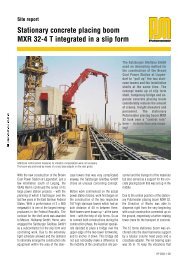
![M 47 Broşürü [.pdf; 527.92 kb] - Putzmeister](https://img.yumpu.com/49631771/1/190x141/m-47-brosuru-pdf-52792-kb-putzmeister.jpg?quality=85)

